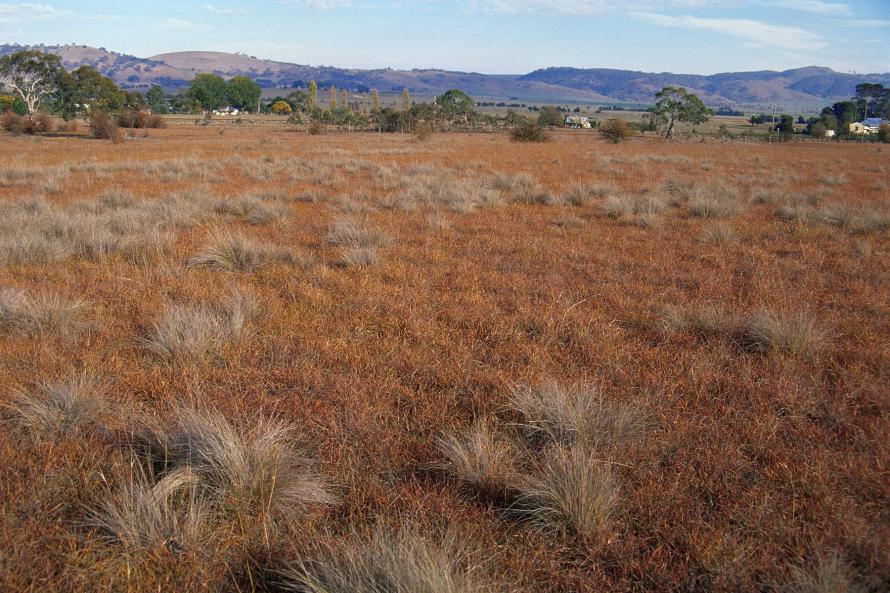
This site has spectacular wildflower displays in spring and summer. It is an especially good site for Golden Moth Orchids, Blue Devil and the Chamomile Burr-daisy. Look for the pair of Nankeen Kestrels hunting or breeding in the big hollows of the old-growth Candlebark trees. In autumn and winter, the dominant Kangaroo Grass takes on lovely rusty hues. There are excellent opportunities for photography at the site as it is in a scenic area.
Hoskinstown Road, 3.75 k south of Bungendore, NSW
24 hour access from the western side of Hoskinstown Road, via gate to the south of the Gidleigh Lane intersection and opposite the entrance to Gidleigh Lane Travelling Stock Reserve.
Interpretative signage at the Hoskinstown Road entrance. No walking tracks
Area Manager, NSW NPWS, 11 Farrer Place, Queanbeyan, NSW, 2620
Phone: 03 6229 7166;
Email: info@environment.nsw.gov.au
Contact hours: 9am-12.30pm Monday to Friday.
Website: http://www.nationalparks.nsw.gov.au/visit-a-park/parks/Turallo-Nature-Re...
Turallo NR was originally gazetted as a travelling stock reserve (TSR), and for many years was under the management of the Braidwood Rural Lands Protection Board. In the late 1980s, it became a vacant crown land, earmarked to be developed as, in turn, an industrial estate and a golf course. Management has been, in turn, TSR grazing, no grazing, recreation and finally, intermittent grazing immediately prior to becoming a nature reserve in 2003.
A highly diverse site with the nationally listed endangered ecological community, Natural Temperate Grassland of the South Eastern Highlands, with the Endangered (Commonwealth) Hoary Sunray, the Vulnerable (NSW) Black Gum and with many other significant and regionally declining flora species. Also has threatened reptiles and birds, with the largest known population of the Vulnerable (NSW) Little Whip Snake in NSW.
Spring and summer wildflowers, scenic values, fauna, including grassland and woodland mammals, birds and reptiles. Some very old Candlebarks are scattered over the site, and there is a small woodland patch with regenerating trees. These woodland elements provide habitat for a range of woodland bird species.
Ongoing management activities include: weed control (woody species and significant grassland weeds such as Chilean Needlegrass, Serrated Tussock and St John's Wort); ecological burning and slashing for biomass management; burning and slashing monitoring using detailed plot monitoring; ongoing reptile monitoring.
Dog walking and vehicle access are not permitted in the reserve.
At least 144 native species, including: Acacia dealbata, Acacia genistifolia, Acaena agnipila, Acaena echinata, Acaena ovina, Ajuga australis, Amphibromus sp., Aristida ramosa, Asperula conferta, Asperula conferta, Austrostipa bigeniculata, Austrostipa scabra, Bothriochloa macra, Brachyscome dentata, Bulbine bulbosa, Calocephalus citreus, Calotis anthemoides, Calotis scabiosifolia, Carex appressa, Carex breviculmis, Carex inversa, Cassinia arcuata, Centella sp., Centipeda cunninghamii, Cheilanthes sieberi, Chloris truncata, Chrysocephalum apiculatum, Chrysocephalum semipapposum, Convolvulus angustissimus, Craspedia variabilis, Crassula sieberiana, Cryptandra amara, Cymbonotus lawsonianus, Cynodon dactylon, Cynoglossum suaveolens, Cyperus sp., Daucus glochidiatus, Daviesia genistifolia, Daviesia mimosoides, Desmodium varians, Dianella longifolia, Dianella revoluta, Dichelachne micrantha, Dichondra repens, Anthropodium fimbriatum, Diuris behrii, Diuris chryseopsis, Drosera peltata, Dysphania pumilio, Einadia nutans, Eleocharis acuta, Elymus scaber, Enneapogon nigricans, Epilobium billardierianum, Eragrostis parviflora, Eriochilus cucullatus, Eryngium ovinum, Eucalyptus aggregata, Eucalyptus rubida, Euchiton involucratus, Euchiton japonicus, Euchiton sphaericus, Euphorbia drummondii, Galium gaudichaudii, Glycine clandestina, Glycine tabacina, Gonocarpus tetragynus, Goodenia hederacea, Goodenia pinnatifida, Haloragis heterophylla, Helichrysum rutidolepis, Hovea linearis, Hydrocotyle laxiflora, Hypericum gramineum, Isoetopsis graminifolia, Juncus australis, Juncus filicaulis, Juncus fockei, Kunzea ericoides, Lachnagrostis sp., Leptorhynchos squamatus, Leucochrysum albicans, Linum marginale, Lissanthe strigosa, Lomandra bracteata, Lomandra filiformis, Lomandra multiflora, Luzula sp., Lythrum hyssopifolia, Melichrus urceolatus, Mentha diemenica, Microlaena stipoides, Microtis unifolia, Montia fontana, Ophioglossum lusitanicum, Oxalis exilis, Oxalis perennans, Panicum effusum, Persicaria prostrata, Pimelea curviflora, Pimelea glauca, Plantago gaudichaudii, Plantago varia, Poa labillardierei, Poa sieberiana, Polygala japonica, Pterostylis cycnocephala, Pterostylis mutica, Ranunculus sp., Rumex brownii, Rumex dumosus, Rytidosperma carphoides, Rytidosperma laeve, Rytidosperma monticola, Rytidosperma setaceum, Schoenus apogon, Scirpus sp., Scleranthus biflorus, Scleranthus diander, Scleranthus fasciculatus, Sebaea ovata, Senecio macrocarpus, Senecio prenanthoides, Senecio quadridentatus, Solenogyne dominii, Solenogyne gunnii, Sorghum leiocladum, Stackhousia monogyna, Stuartina sp., Stylidium graminifolium, Thelymitra pauciflora, Themeda triandra, Thysanotus tuberosus, Tricoryne elatior, Tripogon loliiformis, Triptilodiscus pygmaeus, Velleia paradoxa, Vittadinia cuneata, Vittadinia muelleri, Vittadinia sp., Wahlenbergia communis, Wahlenbergia gracilis and Wurmbea dioica.
An incomplete list of native fauna species includes: Australian Magpie, Australian Pipit, Australian Raven, Australian Wood Duck, Black-faced Cuckoo-shrike, Brown Falcon, Brown Thornbill, Crested Pigeon, Crimson Rosella, Diamond Firetail, Dusky Woodswallow, Eastern Brown Snake, Common Eastern Froglet, Eastern Rosella, Flame Robin, Galah, Gang-gang Cockatoo, Grey Butcherbird, Grey Fantail, Latham's Snipe, Little Corella, Little Raven, Little Whip Snake, Magpie-lark, Nankeen Kestrel, Pacific Black Duck, Pied Currawong, Plumed Whistling-Duck, Red Wattlebird, Rufous Songlark, Rufous Whistler, Scarlet Robin, Spotted Grass Frog, Striated Pardalote, Stubble Quail, Sulphur-crested Cockatoo, Superb Fairy-wren, Three-toed Earless Skink, Tiger Snake, Wedge-tailed Eagle, Welcome Swallow, White-faced Heron, White-plumed Honeyeater, White-winged Triller, Willie Wagtail, Yellow-faced Honeyeater, Yellow-rumped Thornbill and Yellow-tailed Black-Cockatoo.